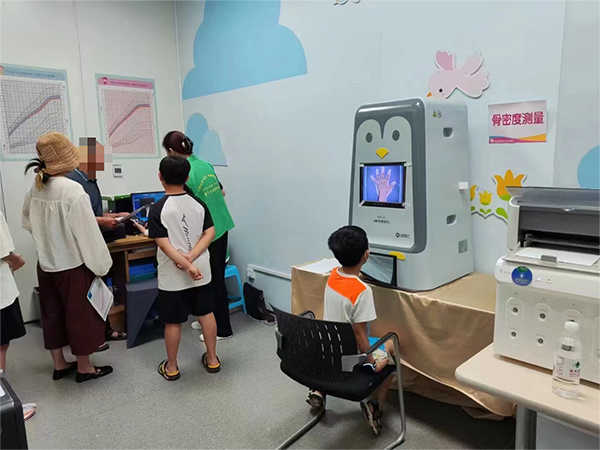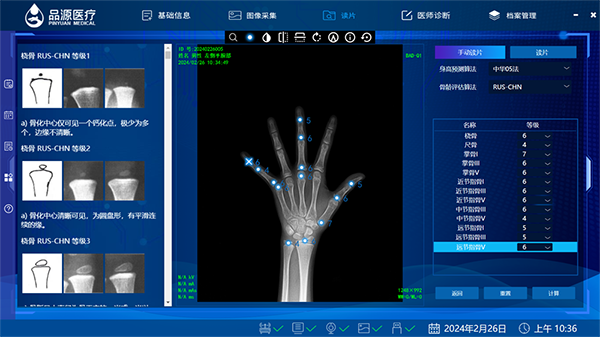First,Definition of bone age
Bone age, also known as bone age, is a unit of measurement of bone maturity in children and adolescents. It is a biological age that reflects the degree of physical development by measuring the size, shape, structure and changes in the relationship between bones, and is expressed in the form of age and in the unit of years. Simply put, bone age is an assessment of an individual's level of growth and development by looking at bone maturity.
Second, the difference between bone age and life age
Before we can understand the importance of bone age, we need to clarify the difference between bone age and life age (i.e. chronological age). Life age refers to the actual age calculated from birth, which increases by one year with each passing year. Bone age, on the other hand, reflects the actual development of bone, which is closely related to multiple factors such as heredity, nutrition, endocrine and environment. Therefore, sometimes there is a certain difference between bone age and life age, and this difference is an important basis for us to evaluate the growth and development of children.
Third. Clinical significance of bone age examination
1. Accurately reflect the level of growth and development and maturity
Bone development has continuity and stages, and different stages of bone have different morphological characteristics. Therefore, bone age examination can accurately assess the growth and development level and maturity of individuals. This is of great significance for understanding the growth and development of children and predicting the future growth and development trend.
2. Determine the biological age of the child
Bone age, as a biological age, can more accurately reflect the growth potential of children and the trend of sexual maturity. Compared with actual age, bone age can better reflect the true situation of children's current developmental state.
3. Predict a child's adult height
Height is one of the important indicators of children's growth and development. Through bone age examination, the adult height of children can be predicted, which has important reference value for parents and doctors. Especially for children with abnormal height development, bone age examination can be found in time and appropriate intervention measures can be taken.
4. Assist in the diagnosis of endocrine diseases
Bone age examination is important for the diagnosis of some pediatric endocrine diseases. For example, endocrine diseases such as growth hormone deficiency and thyroid dysfunction can affect bone development. Through bone age examination, these diseases can be found in time and provide an important basis for diagnosis and treatment.
5. Guide clinical medication
For children with abnormal growth and development requiring medical treatment, bone age examination can guide clinical medication. Based on the results of bone age assessment, doctors can develop a personalized treatment plan to ensure the effectiveness and safety of the drug.
Forth. Which children need bone age tests?
1. Children who develop early
The development of secondary sexual characteristics before the age of 8 in girls and before the age of 9 in boys is considered as precocious puberty. Bone age tests help to assess the growth potential of these children and guide interventions.
2. Obese children
In obese children, the amount of adipose tissue in the body is too high, which will increase the level of estrogen in the body, promote the development of gonads in advance, and accelerate the closure of epiphysis. This can lead to early bone development, affecting eventual height. Therefore, for obese children, bone age examination can detect abnormal bone development in time and take corresponding intervention measures.
3. Children with abnormal height growth
If the child's height growth rate is significantly faster or slower, or the height is significantly lower than or higher than children of the same age and sex, these may be signs of abnormal growth and development. For such children, bone age examination can assess bone maturity, understand growth and development, and take appropriate treatment measures.
4. Premature babies or children born with low height and weight
Premature babies or children born with low birth height and weight may have developmental delays. For such children, bone age examination can assess bone maturity, understand growth and development, and develop appropriate nutrition and treatment plans.
5. Children with a family history of genetic disease
If the child has a family history of genetic diseases such as dwarfism and gigantism, these diseases may affect bone development. For such children, bone age examination can detect abnormal bone development in time and take appropriate intervention measures.
Fifth, how to perform bone age examination?
Bone age tests are done by taking X-rays of the left wrist or knee joint, which are assessed by the doctor based on bone shape and maturity. Common methods include GP mapping and TW2 and TW3 scoring, which can accurately evaluate the bone age of children.
When performing bone age tests, parents and children need to pay attention to the following points:
1. Choose a regular medical institution
A regular medical institution should be selected for bone age examination to ensure the accuracy and reliability of the examination results.
2. Follow your doctor's instructions
When taking an X-ray, the child needs to cooperate with the doctor's guidance, place the hand in the correct position, and remain still to ensure the quality of the X-ray.
3. Interpret the inspection results correctly
Bone age test results should be interpreted and evaluated by a professional physician. Parents should not interpret the test results against the network map to avoid misunderstanding and anxiety.
Sixth, how to correctly view the bone age test results?
1. Understand the difference between bone age and chronological age
It is normal to have some difference between bone age and actual age. Parents do not need to worry too much about the difference between bone age and actual age, but should pay attention to the maturity and growth trend of bones.
2. See your doctor promptly and follow doctor's advice
If the bone age test results show that the child has abnormal growth or risk of disease, parents should bring the child to the doctor in time and follow the doctor's advice for appropriate examination and treatment.
3. Pay attention to the overall development of children
In addition to bone age tests, parents should also pay attention to the overall development of children, including intellectual, psychological, social and other aspects of development. Only a comprehensive assessment of children's development can provide children with more personalized growth support.
Post time: Nov-20-2024


